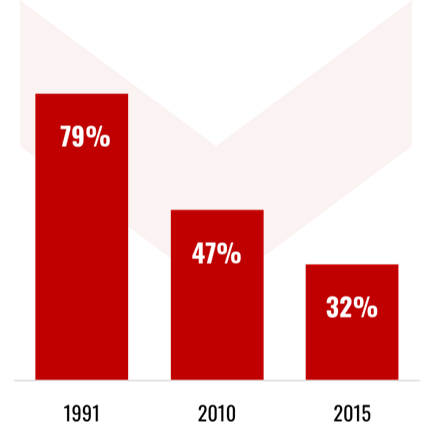Adolescents are thought to be particularly vulnerable to marijuana use, as adolescence is both a time of dramatic brain development and a time when drug use frequently begins. For instance, the average age of first-time marijuana use is 19.4 years old1.
In the U.S., cannabis remains the illicit drug substance most commonly abused by this age group and there is a declining perception of the harm associated with cannabis use. In 2015, only 32% of 12th graders perceived regular cannabis use as risky compared to 47% in 2010 and 79% in 1991. Moreover, nearly 6% of 12th graders reported daily or almost daily cannabis use2. This is particularly concerning given adolescents are at increased risk of developing cannabis use disorder compared to the general population.

Adolescents are thought to be particularly vulnerable to marijuana use, as adolescence is both a time of dramatic brain development and a time when drug use frequently begins. For instance, the average age of first-time marijuana use is 19.4 years old1.
In the U.S., cannabis remains the illicit drug substance most commonly abused by this age group and there is a declining perception of the harm associated with cannabis use. In 2015, only 32% of 12th graders perceived regular cannabis use as risky compared to 47% in 2010 and 79% in 1991. Moreover, nearly 6% of 12th graders reported daily or almost daily cannabis use2. This is particularly concerning given adolescents are at increased risk of developing cannabis use disorder compared to the general population.
While the lifetime risk of dependence in cannabis users has been estimated at less than one in ten, it rises to one in six in those who initiate marijuana use in adolescence3.
The adverse psychosocial consequences of heavy cannabis use in adolescence has been well documented and are similar to the effects seen in chronic adult users. High levels of cannabis use at an early age are associated with:
- Poorer educational outcomes
- Lower income
- Greater unemployment
- Lower relationship satisfaction
- Lower life satisfaction
Early and heavy cannabis use has also been associated with increased violent and criminal behavior and other illicit drug use.
Alterations in Brain Structure and Function May Explain Outcomes
Neuropsychological testing has demonstrated that long-term use of cannabis results in significant decline in executive functioning, memory, learning, and/or cognitive processing speed compared to non-users. Significant declines in intelligence quotient (IQ) have been reported in longitudinal studies of adolescents who developed cannabis dependence4 and in case-control studies of early-onset users compared to late-onset users5. Of note, adult-onset heavy cannabis use was not associated with decreased IQ scores.
Alterations in brain structure and function secondary to cannabis use are further supported by neuroimaging data6. One review of neuroanatomic alterations in heavy cannabis users found that the hippocampus, prefrontal cortex, amygdala, and the cerebellum were the most affected by regular use. Greater dose and earlier age of onset were associated with these changes. The authors noted that these areas are integral to the components of brain reward, memory, and executive-attention and may explain the deficits marijuana users show in these areas. Separate research leveraging magnetic resonance imaging (MRI) found that negative effects of adolescent cannabis use on hippocampal structure was maintained well into late life.
Neuronal connectivity may also be impaired in cannabis users. One study of adults who began to use cannabis regularly as adolescents found marked decreases in the connectivity of the fimbria of the hippocampus – a part of the brain important for memory formation7. These brain alterations may play a key role in the adverse effects experienced by adolescent heavy users.
12th Graders Who Viewed Regular Cannabis Use as Risky

32% of 12th graders perceived regular cannabis use as risky in 2015 compared to 47% in 2010 and 79% in 1991.
About Weedless.org
Weedless.org is a free, web-based resource and community created by a team of healthcare professionals and researchers. We distill the facts about marijuana use and its effects into practical guidance for interested persons or for those who are thinking about or struggling to quit weed. Finding reliable, easy to understand information about marijuana should never be a struggle—that is why our core mission is to provide the most up to date information about marijuana use, abuse, addiction, and withdrawal. While we seek to empower individuals to have control over their use, we are not “anti-weed” and we support efforts to legalize adult marijuana use and study.